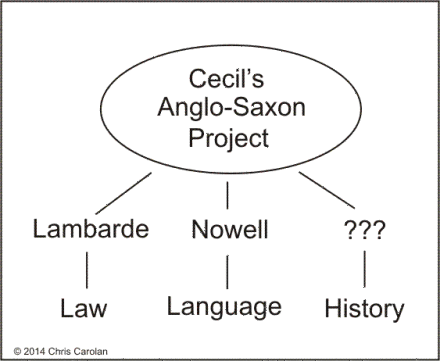A Two-Legged Stool
In reading Rebecca Brackmann’s excellent book, The Elizabethan Invention of Anglo Saxon England Laurence Nowell, William Lambarde, and the study of Old English, her discussion of Lambarde’s work with Anglo-Saxon law and Nowell’s work with the Anglo-Saxon language, both projects within the intellectual circle established at Cecil house, there seemed to be an obvious missing component, a project on Anglo-Saxon history. It occurred to me that she was describing a two-legged stool.
Early in the book she quotes Philip Schwyzer’s Literature, Nationalism and Memory in Early Modern England and Wales.
“Later English nationalism, as it developed through the seventeenth through nineteenth centuries would celebrate a trio of of specifically English virtues: the English language, racial descent from the Anglo-Saxons, and parliamentary and legal traditions and privileges.”
As I read it, racial descent is the missing third-leg of the stool. An obvious part of the project would be to tell the history of the Anglo-Saxons.
This perspective begs the question, was de Vere being groomed/cultivated to write that Anglo-Saxon history? Cecil’s Anglo-Saxon project would have taken shape right after Laurence Nowell’s arrival in 1562. Arthur Golding, de Vere’s uncle who also lived in Cecil house dedicated his translation of Abridgement of the Histories of Trogus Pompeius to the young earl in 1564. It clearly states that Vere is a natural to communicate the histories of ancient times with others.
“I have had experience thereof myself, how earnest a desire your honour hath naturally graffed in you to read, peruse, and communicate with others as well the histories of ancient times, and things done long ago, as also of the present estate of things in our days, and that not without a certain pregnancy of wit and ripeness of understanding.”
Shakespeare’s later history plays are seen by many as Tudor propaganda that effectively supported Elizabeth/Cecil’s regime. A history of the British Isles was written in the 1570s; Holinshed’s Chronicles, which are a primary source of Shakespeare’s history plays. But Holinshed was not a project of Cecil’s intellectual salon. Nor was it a project that began with an Anglo-Saxon focus to be later scaled up to a more comprehensive British Isles content. Rather Holinshed’s project was conceived as a history of all lands that was scaled down to include only the British Isles when the larger project proved unwieldy.
This series of blog posts came about from my investigation into the annotations in the Archaionomia prompted by prof. Roger Stritmatter’s blog post on that topic. Roger’s work is centered around the role the Archaionomia may have played in the authorship of the play Edmund Ironside. Eric Sams and some scholars believe that Ironside is an early Shakespeare play, and a history play at that. Sams’ Shakespeare’s “Edmund Ironside”: The Lost Play posits that the Archaionomia is a source for Ironside. Now I haven’t read either Edmund Ironside or Sam’s book. But I have read, and encourage all to read, Ramon Jiminez’ paper Edmund Ironside, The English King from the 2003 Oxfordian on this topic.
The bottom line is that Ironside is likely a very, early work of de Vere’s. From my perspective, what is interesting is that unlike his later histories, it is not a Tudor history. Edmund Ironside is an Anglo-Saxon history. In the 1580s, Cecil needed Tudor propaganda. In the 1560s, he wanted Anglo-Saxon propaganda as Brackmann amply demonstrates.
Edmund Ironside may be the putative attempt at a third leg of the stool that was Cecil’s Anglo-Saxon project. The conventional wisdom is that the needs of Tudor propaganda were the initial impetus of Shakespeare’s history plays. I suspect that impetus was earlier, and focused on the Anglo-Saxon work of Cecil’s salon of intellectuals in the 1560s, where the young de Vere was present.



3 comments
Brilliant, as usual!
So you think that Ironside is earlier than 1570? I would have said later but my reasoning either way is not very secure.
I don’t know enough to have an informed opinion on the dating, but Jiminez makes a good case for the 1568-1571 time frame, which is when so many of those sources were available, and de Vere had access to manuscripts in Cecil’s library, and he was still closely connected to Cecil’s house, which was the center (along with Parker in Canterbury) of so much Anglo-Saxon research.
Leave a Comment